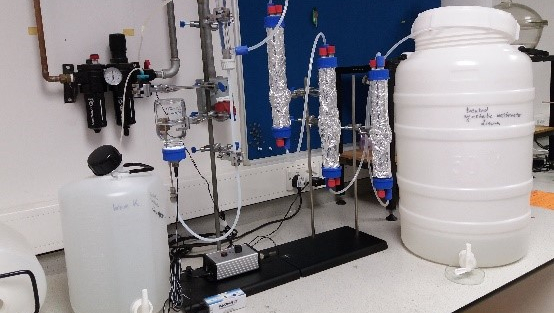Advances in Water Ozonation: Fate of Transformation Products and Gas Transfer through Membranes
This project aims to study the removal of organic trace contaminants during ozonation, as well as investigate membrane ozonation for water treatment.

The project goal is (1) to obtain a deeper understanding on the removal of trace organic contaminants during ozonation, including the fate of ozonation products at subsequent treatment steps and (2) to investigate the efficiency of ozone delivery through membranes. Ozone is among the most promising technologies to remove a wide range of water contaminants that occur at traces in both wastewater effluent and in drinking water resources. Traditionally ozone is injected into water by bubble-based methods, while using membranes for water ozonation is a relatively recent approach.
Therefore, the research has two directions:
a) Ozonation with (bio)filtration post-treatment, with a focus on the fate of ozonation products.
b) To investigate membrane ozonation for water treatment.
Project outline
For part a) A lab-based system was developed that combines continuous ozonation with post-treatment options such as sand filtration or activated carbon filtration. The setup for this system has been previously unavailable and has been newly designed and tested. The developed setup significantly simplifies advanced studies on biodegradability and adsorption of ozonation products. In the initial study pharmaceuticals in wastewater and drinking water matrices served as example, while ongoing experiments look at relevant pesticides in the water cycle.
For part b) Membrane ozonation rigs were developed to investigate bubble-less ozone transfer into water with different membrane materials for both single hollow fibres and whole modules. The results are combined with computational simulations to obtain reliable ozone mass transfer predictions.
Science
For part a) The development of the ozonation-biofiltration system, which was in collaboration with the DVGW-Technologiezentrum Wasser (TZW) in Karlsruhe, Germany, has led to a joint manuscript in Environmental Science: Water Research & Technology, https://doi.org/10.1039/C8EW00855H. This research has also been presented at several international conferences, including the ACS annual meeting in New Orleans.
For part b) Modelling and experimental results for the initial single tube membrane contactor have been published in Water, https://doi.org/10.3390/w10101416. The research has recently been presented in the 9th International Water Association (IWA) Membrane Technology Conference & Exhibition for Water and Wastewater Treatment and Reuse in Toulouse, France.
Impact
The awareness of the impact of trace contaminants in the water cycle has been increasing and is now being taken into account in water quality regulations. There is need for advanced water treatment technologies to be widely adopted. Ozonation is one of the most promising technologies, and needs to be optimised to ensure that its large-scale application is sustainable.
This is the PhD project of Garyfalia Zompouli from the Department of Chemical Engineering. Email address: G.Zoumpouli@bath.ac.uk

